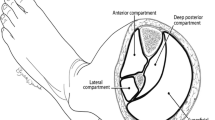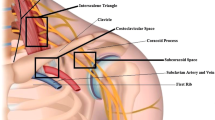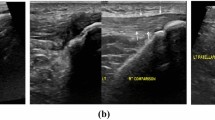Abstract
Acute compartment syndrome (ACS) is a surgical emergency. Diagnosis depends on a high clinical suspicion and an understanding of risk factors, pathophysiology and subtle physical exam findings. The typical high risk scenario for ACS is a male patient younger than 35 years of age, involved in a high energy sport or roadway collision, resulting in a tibial shaft fracture. He will go on to develop acute compartment syndrome of the leg in less than 10 hours and require emergent fasciotomy. Diagnosis of ACS in this patient is primarily a clinical one but can be confirmed with invasive intracompartmental pressure monitoring or non-invasive near infrared spectroscopy (NIRS). Delaying the diagnosis will likely result in some degree of permanent disability and places the surgeon at high risk for litigation. This article reviews the salient features of acute compartment syndrome that should be understood by all orthopaedic residents and surgeons.

Similar content being viewed by others
References
Papers of particular interest, published recently, have been highlighted as: •• Of major importance
McQueen MM, Gaston P, Court-Brown CM. Acute compartment syndrome. Who is at risk? J Bone Joint Surg Br. 2000;82:200–3.
Shadgan B, Menon M, Sanders D, et al. Current thinking about acute compartment syndrome of the lower extremity. Can J Surg. 2010;53:329–34.
Kalyani BS, Fisher BE, Roberts CS, et al. Compartment Syndrome of the Forearm: A Systematic Review. J Hand Surg Am. 2011;36:535–43.
Leversedge FJ, Moore TJ, Peterson BC, Seiler III JG, et al. Compartment Syndrome of the Upper Extremity. J Hand Surg. 2011;36:544–60.
McQueen MM, Christie J, Court-Brown CM. Compartment pressures after intramedullary nailing of the tibia. J Bone Joint Surg Br. 1990;72:395–7.
Tiwari A, Hag AI, Myint F, et al. Acute compartment syndromes. Br J Surg. 2002;89:397–412.
Hayes G, Liauw S, Romaschin A, et al. Separation of reperfusion injury from ischemia-induced necrosis. Surg Forum. 1988;39:306–8.
Har-Shai Y, Silbermann M, Reis ND, et al. Muscle microcirculatory impairment following acute compartment syndrome in the dog. Plast Reconstr Surg. 1992;89:283–9.
Lindsay T, Liauw F, Romaschin S, et al. The effect of ischemia/reperfusion on adenine nucleotide metabolism and xanthine oxidase production in skeletal muscle. J Vasc Surg. 1990;12:8–15.
Blaisdell FW. The pathophysiology of skeletal muscle ischemia and the reperfusion syndrome: A review. Cardiovasc Surg. 2002;10:620–30.
Jennische E. Ischemia-induced injury in glycogen-depleted skeletal muscle: selective vulnerability of the FG-fibres. Acta Physiol Scand. 1985;125:727–34.
Petrasek PF, Homer-Vanniasinkam S, Walker PM. Determinants of ischemic injury to skeletal muscle. J Vasc Surg. 1994;19:623–31.
Bae DS, Kadiyala RK, Waters PM. Acute Compartment Syndrome in Children: Contemporary Diagnosis, Treatment, and Outcomes. J Pediatr Orthop. 2001;21:680–8.
McQueen MM, Christie J, Court-Brown CM. Acute compartment syndrome in tibial diaphyseal fractures. J Bone Joint Surg Br. 1996;78:95–8.
Badhe S, Baiju D, Elliot R, et al. The ‘silent’ compartment syndrome. Injury. 2009;40:220–2.
•• Shuler FD, Dietz MJ. Physicians’ ability to manually detect isolated elevations in leg ICP. J Bone Joint Surg Am. 2010;90:361–7. This publication is important in that it shows how poor we are as physicians in clinically detecting increased intracompartmental pressures by manual palpation alone. Other means of diagnosis and monitoring should be employed in addition to manual palpation in order to avoid missing a developing compartment syndrome and its catastrophic sequelae.
Ulmer T. The Clinical Diagnosis of Compartment Syndrome of the Lower Leg: Are Clinical Findings Predictive of the Disorder? J Orthop Trauma. 2002;16:572–7.
Staudt JM, Smeulders MJ, van der Horst CM. Normal compartment pressures of the lower leg in children. J Bone Joint Surg Br. 2008;90:215–9.
Moed BR, Thorderson PK. Measurement of ICP: A comparison of the slit catheter, side-ported needle, and simple needle. J Bone Joint Surg Am. 1993;75:231–5.
Seiler III JG, Womack S, De L’Aune WR, et al. Intracompartmental pressure measurements in the normal forearm. J Orthop Trauma. 1993;7:414–6.
Heckman MM, Whitesides Jr TE, Grewe SR, et al. Compartment pressure in association with closed tibial fractures: The relationship between tissue pressure, compartment, and the distance from the site of the fracture. J Bone Joint Surg Am. 1994;76:1285–92.
Matsen FA, Winquist RA, Krugmire RB. Diagnosis and Management of Compartmental Syndromes. J Bone Joint Surg Am. 1980;62:286–91.
Mubarak SJ, Owen CA, Hargens AR, et al. Acute compartment syndromes: diagnosis and treatment with the aid of the wick catheter. J Bone Joint Surg Am. 1978;60:1091–5.
McQueen MM, Court-Brown CM. Compartment monitoring in tibial fractures: The pressure threshold for decompression. J Bone Joint Surg Br. 1996;78:99–104.
Heckman MM, Whitesides Jr TE, Grewe SR, et al. Histologic determination of the ischemic threshold of muscle in the canine compartment syndrome model. J Orthop Trauma. 1993;7:199–210.
Matava MJ, Whitesides Jr TE, Seiler III JG, et al. Determination of the compartment pressure threshold of muscle ischemia in a canine model. J Trauma. 1994;37:50–8.
Bernot M, Gupta R, Dobrasz J, et al. The effect of antecedent ischemia on the tolerance of skeletal muscle to increased interstitial pressure. J Orthop Trauma. 1996;10:555–9.
Iaquinto JM, Pienkowski D, Thornsberry R, et al. Increased neurologic complications associated with postoperative epidural analgesia after tibial fracture fixation. Am J Orthop. 1997;26:604–8.
Strecker WB, Wood MB, Bieber EJ. Compartment syndrome masked by epidural anesthesia for postoperative pain. Report of a case. J Bone Joint Surg Am. 1986;68:1447–8.
Harrington P, Bunola J, Jennings AJ, et al. Acute compartment syndrome masked by intravenous morphine from a patient-controlled analgesia pump. Injury. 2000;31:387–9.
Maheshwari R, Taitsman LA, Barei DP. Single-Incision Fasciotomy for Compartmental Syndrome of the Leg in Patients With Diaphyseal Tibial Fractures. J Orthop Trauma. 2008;22:723–30.
Chloros GD, Papadonikolakis A, Ginn S, et al. Pronator quadratus space and compartment syndrome after low-energy fracture of the distal radius: a case report. J Surg Orthop Adv. 2008;17:102–6.
Summerfield SL, Folberg CR, Weiss AP. Compartment syndrome of the pronator quadratus: a case report. J Hand Surg. 1997;22:266–8.
Gelbernam RH, Zakaib GS, Mubarak SJ, et al. Decompression of Forearm Compartment Syndromes. Clin Orthop Relat Res. 1978;134:225–9.
Janzing HM, Broos PL. Dermatotraction: An Effective Technique for the Closure of Fasciotomy Wounds: A Preliminary Report of Fifteen Patients. J Orthop Trauma. 2001;15:438–41.
Zorilla P, Mariin A, Gomez LA, et al. Shoelace Technique for Gradual Closure of Fasciotomy Wounds. J Trauma. 2005;59:1515–7.
Chiverton N, Redden JF. A new technique for delayed primary closure of fasciotomy wounds. Injury. 2000;31:21–4.
Zannis J, Angobaldo J, Marks M, et al. Comparison of Fasciotomy Wound Closures Using Traditional Dressing Changes and the Vacuum-Assisted Closure Device. Ann Plast Surg. 2009;62:407–9.
Weiland DE. Fasciotomy closure using simultaneous vacuum-assisted closure and hyperbaric oxygen. Am Surg. 2007;73:261–6.
Van der Velde M, Hudson DA. VADER (Vacuum-Assisted Dermal Recruitment) A New Method of Wound Closure. Ann Plast Surg. 2005;6:660–4.
Walker T, Gruler M, Ziemer G, et al. The use of a silicon sheet for gradual wound closure after fasciotomy. J Vasc Surg. 2012;55:1826–8
Harrah J, Gates R, Carl J, et al. A Simpler Less Expensive Technique for Delayed Primary Closure of Fasciotomies. Am J Surg. 2000;180:55–7.
Mbubaegbu CE, Stallard MC. A method of fasciotomy wound closure. Injury. 1996;27:613–5.
Taylor RC, Reitsma BJ, Sarazin S, et al. Early Results Using a Dynamic Method for Delayed Primary Closure of Fasciotomy Wounds. J Am Coll Surg. 2003;197:872–8.
Narayanan K, Latenser BA, Jones LM, et al. Simultaneous primary closure of four fasciotomy wounds in a single setting using the Sure-Closure™ device. Injury. 1996;27:449–51.
Fitzgerald AM, Gaston P, Wilson Y, et al. Long-term sequelae of fasciotomy wounds. Br J Plast Surg. 2000;53:690–3.
Velmahos GC, Theodorou D, Demetriades D, et al. Complications and Nonclosure Rates of Fasciotomy for Trauma and Related. Risk World J Surg. 1997;21:247–53.
•• Flynn JM, Bashyal RK, Yeger-McKeever M, et al. Acute Traumatic Compartment Syndrome of the Leg in Children: Diagnosis and Outcome. J Bone Joint Surg Am. 2011;93:937–41. This paper outlines the difficulties and delays that arise when managing pediatric patients with compartment syndrome. Flynn et al. compiled the largest series of pediatric patients to develop compartment syndrome in recent years. Their data suggest that ACS manifests in unique ways as compared to adults and although diagnosis and treatment are often delayed, permanent disability is rare.
Erdos J, Dlaska C, Szatmary P, et al. Acute compartment syndrome in children: a case series in 24 patients and review of the literature. Int Orthop. 2010;35:569–57.
Vaillancourt C, Shrier I, Falk M, et al. Quantifying delays in the recognition and management of acute compartment syndrome. CJEM. 2001;3:26–30.
Bhattacharyya T, Vrahas MS. The Medical-Legal Aspects Of Compartment Syndrome. J Bone Joint Surg Am. 2004;86:864–8.
Garr J, Gentilello LM, Cole PA, et al. Monitoring for Compartmental Syndrome Using Near-Infrared Spectroscopy: A Noninvasive, Continuous, Transcutaneous Monitoring Technique. J Trauma. 1999;46:613–8.
Arbabi S, Brundate SI, Gentilello LM. Near-Infrared Spectroscopy: A Potential Method for Continuous, Transcutaneous Monitoring for Compartmental Syndrome in Critically Injured Patients. J Trauma. 1999;47:829–33.
Mancini DM, Bolinger L, Li H, et al. Validation of near-infrared spectroscopy in humans. J Appl Physiol. 1994;77:2740–7.
Gentilello LM, Sanzone A, Wang L, et al. Near-infrared spectroscopy versus compartment pressure for the diagnosis of lower extremity compartmental syndrome using electromyography-determined measurements of neuromuscular function. J Trauma. 2001;51:1–8.
Sanchez de Toledo J, Chrysostomou C, Wearden PD. Acute compartment syndrome in a Patient on Extracorporeal Support: Use of Near-Infrared Spectroscopy. J Cardiothorac Vasc Anesth. 2011;25:836–7.
Shuler MS, Reisman WM, Cole AL, et al. Near-infrared spectroscopy in acute compartment syndrome: Case report. Injury. 2011;42:1506–8.
•• Shuler MS, Reisman WM, Kinsey TL, et al. Correlation Between Muscle Oxygenation and Compartment Pressures in Acute Compartment Syndrome of the Leg. J Bone Joint Surg Am. 2010;92:863–70. The importance of this publication is that it establishes near infrared spectroscopy as a viable way to follow perfusion pressure in patients with developing compartment syndrome. A significant correlation was found between decreased perfusion pressure and decreasing near infrared spectroscopy values in patients with known increased intracompartmental pressure.
Giannotti G, Cohn SM, Brown M, et al. Utility of near-infrared spectroscopy in the diagnosis of lower extremity compartment syndrome. J Trauma. 2000;48:396–9.
Shuler MS, Reisman WM, Whitesides TE, et al. Near-Infrared Spectroscopy in Lower Extremity Trauma. J Bone Joint Surg Am. 2009;91:1360–8.
Ouellette EA. Compartment syndromes in obtunded patients. Hand Clin. 1998;14:431–50.
Disclosure
RM Taylor: none; MP Sullivan: none; S Mehta: consultant for Synthes, Smith & Nephew; receives payment for lectures from AO North America, Zimmer, Smith & Nephew.
Author information
Authors and Affiliations
Corresponding author
Rights and permissions
About this article
Cite this article
Taylor, R.M., Sullivan, M.P. & Mehta, S. Acute compartment syndrome: obtaining diagnosis, providing treatment, and minimizing medicolegal risk. Curr Rev Musculoskelet Med 5, 206–213 (2012). https://doi.org/10.1007/s12178-012-9126-y
Published:
Issue Date:
DOI: https://doi.org/10.1007/s12178-012-9126-y
Keywords
- Compartment syndrome
- Acute compartment syndrome
- Pediatric compartment syndrome
- Missed compartment syndrome
- Intracompartmental pressure monitoring
- Muscle death
- Pathophysiology
- Lower extremity fasciotomy
- Upper extremity fasciotomy
- Fasciotomy
- Tibia fracture
- Lower extremity trauma
- Upper extremity trauma
- Pressure
- Intracompartmental pressure
- Stryker needle
- Slit catheter
- Medicolegal
- Wound closure
- Negative pressure wound therapy
- Near infrared spectroscopy
- Trauma




